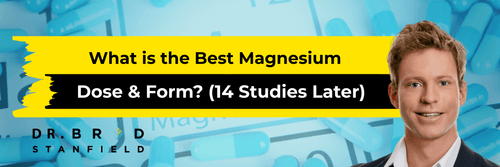Heart disease is the world’s biggest killer. And it’s only getting worse. [1]
But there’s a safe, easy, and ridiculously cheap way to slash our risks. A brand-new study has reinforced how effective it can be, and I’ll explain why I take it—even though I’m young and healthy.
Table of Contents
The New Study
Researchers were curious about the way we usually treat heart disease. When someone has had a heart attack, the clinical guidelines say we need to get their low-density (or LDL) cholesterol lowered as much as possible. We’ve found this is one of the best things we can do to reduce their odds of more heart attacks and other complications.

But the standard guidelines take a somewhat surprising approach. In addition to diet and exercise, they advise starting someone out with high-dose statins and then moving to combination therapy if the statins alone don’t lower LDL cholesterol enough. Combination therapy just means adding another type of medication alongside statins to get a stronger effect.
This approach is surprising because we already know combination therapy after a heart attack achieves lower LDL cholesterol levels and better outcomes than statins alone. And more than 80% of patients end up needing to move to combination therapy. [2]
So researchers wondered: What would happen if we just started patients on combination therapy right away after a heart attack, instead of waiting to see if statins alone were enough? [3]
In other words, if we know something helps and most people end up needing it, could we see better outcomes if we start using it right away instead of waiting?
They looked at a huge population of people in Sweden who had experienced a heart attack and divided them into three groups based on their medications: one started combination therapy early, one started it later, and one just stuck with statins. They followed patients for an average of about four years and measured things like heart attacks and strokes.
The results were striking. Compared to the early combination therapy group, the group that started later had a significantly higher risk of death from heart disease. The group that just stuck with statins alone had an even higher risk. [3]
So the answer to their question was pretty clear: starting patients early on combination therapy can save a lot of lives and deliver better outcomes overall.
Clearing Objections
Now, this study was focused on those who had already had a heart attack. But there’s a much broader lesson we should all be paying attention to. It’s changed how I personally approach my heart health, which I’ll explain shortly. First, though, I need to address some pushback that comes up whenever I talk about cholesterol.

As a clinician, I’m always having to respond to this objection that my patients hear online from certain health influencers: “High LDL cholesterol isn’t actually a problem. This is just a myth created by companies who want to sell us medications.”
Sometimes people online argue that it’s actually low cholesterol that’s most dangerous to our health. Supporters of this story will point to some studies that include graphs showing the relationship between LDL cholesterol and all-cause mortality, with the highest risks at the lower levels. [4]

So what’s going on here? Is there really some kind of conspiracy on the part of doctors and pharmaceutical companies to push unnecessary meds—especially bearing in mind that statins and Ezetimibe are off-patent and ridiculously cheap?
The first thing to notice is that we see this U-shaped pattern in many health metrics. A meta-analysis on BMI in older adults, for instance, has a chart that looks similar. [5]

Are we to believe that to be healthy, we should all aim to be overweight?
It’s the same pattern for blood pressure. [6]

If there’s a conspiracy, it seems to show up everywhere in medicine! But the actual explanation of the pattern has nothing to do with conspiracies or deception. Here’s the truth:
People who fall on the very low end for metrics like cholesterol, body mass index, and blood pressure often fall into two categories: older adults and the chronically ill. In old age, we start to see a lot more health problems, and these can impact these metrics. Think of BMI, for instance. As we reach advanced age, our appetite can decrease, we eat less, and our weight goes down—so we see lower BMI levels. At the same time, we see higher mortality rates in this age group.
Similar logic applies to the chronically ill. Very low cholesterol levels can be caused by liver disease and cancer, and these conditions also raise mortality rates.
But when studies are careful to correct for factors like old age and chronic disease that distort the results, we tend to see a different picture. For example, one large cohort study looked at over 40,000 patients and their overall mortality. Initially, it looked like there was a high death risk at the left side of the graph (the lowest non-HDL cholesterol levels).

But after adjusting for age, malnutrition, and other markers of poor health, the U-shape disappeared. Higher levels of cholesterol were clearly associated with greater mortality risks. [7]

Observational studies can be limited, so we also look at a wider range of research. When we turn to large reviews—such as one examining over 200 studies, including randomized controlled trials involving more than 2 million people—we still see a consistent pattern: higher amounts of LDL cholesterol in the blood correlate with a higher rate of heart disease. [8] The link is so strong that the study authors concluded that the evidence shows LDL causes heart disease.

But what if you’re otherwise healthy? You’ll hear online that if you’re at a perfect weight with no diabetes or insulin sensitivity issues, and your blood pressure is perfect, then you don’t need to worry about blood cholesterol levels.
A major study called the PESA study helps answer this question. It shows that blockages in our arteries can develop if LDL-C is above about 50-60 mg/dL, even if all other risk factors are optimal. [9][10]

And this point is timely, since a new study has been making the rounds on social media. People are interpreting it as showing that super high levels of LDL cholesterol can be safe for certain individuals who are on ultra-low-carb diets and are so-called “lean mass hyper-responders.” [11] These people were extremely healthy except for sky-high LDL-C levels. As expected, they experienced rapid plaque progression in their blood vessels.
I cover that research in more detail in a separate piece, but personally, I want to lower my risk of dying from heart disease as much as possible—especially when there are safe and highly effective strategies we can use.
Medications for Lowering LDL-C
Which brings us back to the main lesson we can draw from the new study we started with. Let me explain the lesson, how I’ve personally responded, and the takeaways you might consider for your own health.

First, it’s crucial to emphasize that when it comes to improving our health outcomes, getting regular exercise and having a solid diet are musts. These are two of the most powerful levers we can pull to modify our risks.
Some elements of our diet—like fiber—can be particularly helpful. That’s why I include psyllium husk, which has been shown to have cholesterol-lowering effects, in a supplement I use. But just because I take a supplement doesn’t mean you have to.
What I see in the clinic, however, is that diet and exercise alone are often not enough to hit more aggressive LDL cholesterol targets. That’s when we talk about low-dose statins, which are a first-line medication to help bring down levels.
Many blogs and YouTube channels say statins cause dementia. But this concern has been disproven in multiple clinical trials. [14] In fact, the latest clinical guidelines suggest statin use might reduce dementia risk. [13]
Statins also don’t affect testosterone levels. [15] And muscle pains are relatively rare—about 1 to 2 patients out of 100. [16][17] Those risks are even lower with low-dose therapy, which provides around 70% of the LDL-lowering effect of a high dose, with a much lower likelihood of side effects.
Now, if we want to push our LDL levels even lower, we can add Ezetimibe. It’s very well-tolerated: only a small minority of patients experience mild gastrointestinal issues, and those usually resolve. This was the medication used for combination therapy in the study mentioned earlier. It has a different mechanism of action than statins (reducing how much cholesterol is absorbed in the intestines rather than how much is produced in the liver). Together, they can deliver a dramatic impact.
A recent meta-analysis showed that combination therapy lowers cholesterol levels more and is better tolerated compared to high-dose statins alone. [18] In short, combining a low- or moderate-dose statin with Ezetimibe can get us superior cholesterol-lowering outcomes with fewer side effects.
And that’s the lesson of the new study: heart disease is the result of a cumulative process, where damage slowly builds in our arteries. Starting early can pay big dividends in the long run. In the research, the group that began combination therapy right away saw the greatest benefits over time. [3]

There’s no reason to wait until we’ve already had a heart attack. We can tap into these cumulative benefits by starting earlier—and it’s also never too late to start. Another analysis from the U.K. looked at those with no previous heart disease who used statins as a preventive measure and found that benefits build over a lifetime. [12]
In light of this, I personally take a low-dose statin called pravastatin (20 mg at night), which is a recent change from rosuvastatin (5 mg). In the U.S., it’s only a few dollars per month. [19]
I also take Ezetimibe (10 mg a day). [20] People are surprised because I’m young and healthy, yet I’m on two meds to lower my cholesterol. But hopefully you can see my logic: I want to keep my LDL cholesterol low now, to prevent plaque buildup in my arteries as I age. Heart disease is the world’s number-one killer. If I can take two cheap, safe medications that minimize my risks, it’s a no-brainer for me.
Reference List
2. https://www.sciencedirect.com/science/article/pii/S0735109725003596
3. https://www.sciencedirect.com/science/article/pii/S0735109725003596
4. https://www.nature.com/articles/s41598-021-01738-w
5. https://www.sciencedirect.com/science/article/pii/S0002916523050244#f2
6. https://www.sciencedirect.com/science/article/pii/S0735109714029088
7. https://www.sciencedirect.com/science/article/pii/S0261561422000371
8. https://pubmed.ncbi.nlm.nih.gov/28444290/
9. https://www.sciencedirect.com/science/article/pii/S0735109721051159?via%3Dihub
10. https://www.sciencedirect.com/science/article/pii/S0735109721051159?via%3Dihub
11. https://www.jacc.org/doi/10.1016/j.jacadv.2025.101686
12. https://academic.oup.com/eurheartj/article/43/Supplement_2/ehac544.2850/6746257
13. https://www.thelancet.com/journals/lancet/article/PIIS0140-6736(24)01296-0/fulltext
14. https://pubmed.ncbi.nlm.nih.gov/25575908/
16. https://www.thelancet.com/article/S0140-6736(22)01545-8/fulltext
17. https://www.ncbi.nlm.nih.gov/pmc/articles/PMC7613583/
18. https://pubmed.ncbi.nlm.nih.gov/39135464/
19. https://www.costplusdrugs.com/medications/pravastatin-20mg-tablet/
20. https://www.costplusdrugs.com/medications/ezetimibe-10mg-tablet/























































